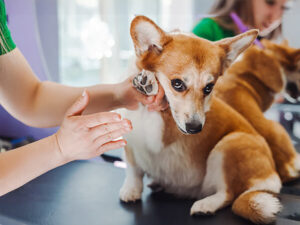We all love our little (or not so little) pet dogs, and want to make sure they are happy, healthy, and comfortable for all of their days. Grooming is a key part of that commitment we make as pet owners. It serves several important additional purposes, including allowing you to spot changes to your dog’s body or health conditions, as well as building a strong bond between you and your pet. That’s why most experts advise you to do as much pet grooming as you can yourself, and not rely solely on a groomer. That’s the first of several good pieces of expert grooming advice that all pet owners should heed.
Professional groomers provide a valuable service, and they are definitely worth using on occasion to pamper your pet. Many people prefer to use a groomer to get their dog ready for seasonal changes, or to look their best before holiday photo shoots and things of that nature. Others prefer to rely on groomers for more complex or sensitive tasks, such as nail trimming.
Finding the right balance between at-home grooming and professional groomers is something you will have to navigate for yourself, with your pet at your side. It’s also an important consideration if your dog is particularly anxious, bad with strangers, and so on – they may be calmer and more receptive to being groomed by you rather than a professional. Whatever the case may be for you and your pupper, let’s take a look at some of the top expert grooming advice for typical grooming tasks to keep your furry friend in tip-top shape.
Bathing
Most experts agree, as a matter of dog grooming advice and general guidelines, that dogs shouldn’t be bathed more frequently than once per month. Spot-bathing or cleaning if they roll in dirt or something stinky is certainly acceptable. But assuming normal conditions, you can probably go 2 to 3 months between baths depending on breed, degree of shedding, and smell. Bathing too frequently can irritate your dog’s skin, and remove essential oils and other compounds from their coat.
Additionally, when you bathe your pet, you need to use a shampoo and conditioner that are designed for dogs. Experts suggest you use the mildest formulation possible – and never substitute human products for your dog as they are too harsh. Rinsing thoroughly and following bottle instructions for use are likewise extremely important – shampoo or conditioner residue left in your dog’s coat can also cause irritation and discomfort. Antiseptic or anti-fungal shampoos are also useful, especially if your dog tends to get into messes on a frequent basis. Alternatively, for spot cleaning, alcohol-free bath wipes can be a good choice.
ALSO READ – The Top 5 Dog Grooming Mistakes You Should Avoid
Brushing and Combing
Brushing and combing your pet’s fur or coat helps to remove dead hairs, prevent tangles, matting, and knots, and keeps your pet looking and feeling good. It also removes dirt, debris, and other matter that can get stuck in their coat due to life activities. Unlike bathing, brushing and combing can be done every few days – in fact, that frequency is encouraged by experts. It helps to distribute the oils in your pet’s coat, which further reinforces the anti-matting and knotting effects. It helps control shedding and stray hair buildup in your home, too, which is always a win. Be sure to invest in a good quality grooming brush and comb, and follow our separate guides and tutorials on the correct methods to use for the best results.
Trimming Nails
Trimming your dog’s nails is often one of the scarier tasks for many pet owners, who would rather leave it to a groomer or a vet. So it’s no surprise that there’s expert grooming advice for this aspect of caring for your pet. There’s a fear among many owners that they might cut too much, causing the dog pain and bleeding, and no responsible pet owner wants to hurt their pet. Still, they need their nails trimmed – if they aren’t properly maintained, they can curl and curve, making it painful and difficult for your dog to walk, sometimes causing permanent damage.
Experts generally offer grooming advice that’s based around using a quality nail trimmer designed to cut your dog’s nails, first and foremost. Never use human nail clippers. A good trimmer will fit easily in your hand, and will have a safe, enclosed blade. There are different sizes available depending on the size of your four-legged friend. If you’re unsure which to choose, talk to your groomer or vet and see what they recommend. Be sure to read up on how to trim your dog’s nails, or ask your vet or groomer to demonstrate, before you try it for the first time.
Tooth and Mouth Care
Dental care is also an important aspect of grooming and health for dogs. Yet, it’s an area of dog grooming that is often neglected by many owners, and consequently part of the grooming advice offered here. It’s a myth that a dog’s mouth and teeth are entirely self-cleaning and don’t require any attention. Their teeth are susceptible to the same kinds of dental problems that humans can develop, and likewise with their gums. Gum disease, tartar buildup, cavities, chipped teeth – all of these problems can develop in dogs, just as in humans. Dental dog treats and chews can help, but periodically it can be beneficial to brush your dog’s teeth, on the outer side of their mouth, with just plain water, using a microfiber cloth or similar wrapped around your finger. Never use toothpaste or mouthwash meant for humans on your dog.
Dealing with Anxiety
One of the hardest parts of grooming your pet can be getting them to be calm and still. Many dogs are anxious or nervous, and can be even more so around strangers (professional groomers) compared to just their owners. Other dogs, often rescues, may have issues being touched or even approached by people they don’t know, especially if they have a history of abuse or being neglected. In any case, these anxieties and quirks can spill over into grooming, making it difficult or impossible for either a professional groomer or pet owner to properly groom their pet.
Fortunately, there are approaches that can help to reassure your furry friend and calm them down. Options include:
- Training courses or methods to better acquaint your dog with being touched, especially in areas they may shelter such as their underbelly, tail, paws, and face. You can practice this on your own, follow an online course, or enroll them in a professional training course depending on your needs, severity of the problem, financial resources, etc.
- Using treat training during grooming can help your dog have a positive association with the grooming process. Just be careful not to overdo it and stuff your dog full of treats beyond what is reasonable. Take it slow and gradually build up to more time in between giving treats during a grooming session.
- Calming treats are available, that have natural ingredients to help calm anxious dogs and mellow them out a bit. These are worth trying – just be sure to read the instructions and not give too many to your dog, or they may become loopy, lethargic, or seem “stoned.”
- A lot of dogs get nervous when grooming implements come out, and may associate them with discomfort. It’s important to allow your dog to see the implements, sniff, lick them, and so on, to become accustomed to them. Don’t spring them on your dog from behind your back or from hiding – it won’t make things any easier in the long run.
ALSO READ – Everything You Need to Know About Dog Shaving






